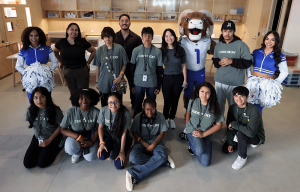
Education
California Students Remain Behind After COVID-19
As we mark five years since the COVID-19 pandemic began, and roughly two years since California’s official COVID-19 state of emergency ended, few visible signs of the pandemic remain across California. But, upon closer examination, the damage of COVID-19 remains clearly visible in California’s educational pipeline.
Student test scores took a sharp dive as schools closed – and have yet to recover. Comparing statewide standards from last year (2023–2024) to pre-pandemic scores (2018–2019) paints a stark picture.
Across all ages, the percentage of California students meeting statewide goals in education and math dropped approximately 4%, with only 35.5% and 51.1% of students meeting math and English language arts standards in the 2023–2024 academic year, respectively. This across-the-board drop also hides more nuanced differences among populations and subject matters. Focusing on 11th grade test scores (the highest age at which standardized tests are conducted), the percentage of students meeting state standards rises to 55.7% for English, but falls sharply for mathematics, with only 27.9% of students meeting state math standards. And this severe lack of mathematics is even more extreme for students of color; passage rates for Latino, African American, and Native American students were all below 14.1% in the 2023–2024 academic year. Moreover, data from the Northwestern Evaluations Association (a not-for-profit focused on student testing) suggests that the gap between pre-COVID and post-COVID test scores widened in 2023-2024 in nearly all grades.
Thankfully, more and more academic research is focusing on this learning loss – and helping policymakers understand its implications.
Recent research coming out of Harvard and Stanford’s joint “Education Recovery Scorecard” suggests that, though students are learning once again, they cannot be expected to catch up to prior percentages without increased classroom time.
“Children have resumed learning, but largely at the same pace as before the pandemic. There’s no hurrying up teaching fractions or the Pythagorean theorem.”
— Stanford Professor Thomas Kane
These decreases in test scores have real-world implications for the economic health of young Californians. Researchers at Harvard University found that there was a real-world correlation between middle school mathematics scores and lifetime earnings, and therefore project that pandemic-affected students may see decreased lifetime earnings.
Tidal Wave Of Retirements Expected In 2025-2027
Just as our educational pipeline is faltering, California’s employers are looking at a looming wave of retirements and an anticipated need to replace employees with those critical skills. Approximately 4.1 million Americans will turn 65 this year — and every year through 2027 — meaning that the economy is likely to experience a wave of retirements. And this aging trend is going to continue. In 2022, 15.8% of the state’s population was 65 or older, but the California Department of Finance projects that about one in four (23.1%) Californians will be 65 or older by 2040. Although long-term workers have certainly earned their retirement, the question confronting employers is: who will replace them? Hopefully, the answer is: a new generation of qualified Californians.
But will they be ready? If policy makers do not take seriously the COVID-19 learning gap — as well as longtime deficiencies in science, technology, engineering, and mathematics (STEM) education, then California’s employers and California’s economy may be hamstrung by a lack of skilled and educated workers. And if young Californians are not ready to fill these critical roles, where are these workers to come from?
Present Workforce Issues: Youth Disconnection and COVID-19 Departures
Even before the expected retirement tsunami hits California in 2025–2027, California’s economy is already being hampered by a lack of qualified workers, particularly in blue collar jobs. Many of the workers who left the economy during the COVID-19 pandemic never returned — and younger workers have not filled those gaps.
Youth unemployment rates remain strikingly high. In August 2024, the unemployment rate for 16–19-year-olds was 21.4% — approximately four times the all-ages statewide rate of 5.3%. And the issues don’t stop at age 20; a new report from Beacon Economics suggests that 90% of the newly unemployed between January 2023 and June 2024 were under 35.
As a matter of policy, these trends suggest that young Californians are not gaining the workplace skills they need in critical early years, and that their lifetime earnings will be lower than their predecessors. In short, they are losing a piece of their American dream because the education pipeline and economic realities are not putting them on the right path.
Policy Solutions Needed, Despite Tight Budgets
Policy makers must look to cost-effectively streamline and improve educational pipelines to help young Californians build the skills necessary to join the workforce. These solutions will not be easy considering the lean 2024–2025 budget and the anticipated lean budget cycles in subsequent years.
California’s youth — and diverse immigrant population — must be given the skills needed to fit into California’s workforce by California’s educational pipeline. This is an imperative, not just for California’s employers, but for California’s workers as well. Looking at the situation from the perspective of individual workers, each Californian deserves a chance to earn the training and skills needed to support themselves and their families and enjoy the opportunities of a rewarding career path.
California’s economy needs all kinds of labor — including workers with technical skills, college degrees, and even post-graduate degrees. Although advanced degrees and technical training statistically improve incomes, not all Californians have the same opportunity for those improved outcomes. According to the Public Policy Institute of California (PPIC), low-income, first-generation Latino and African American students — who make up most of the state’s public high school attendees — are less likely to graduate from high school, enroll in college, and graduate from college than their peers. And even brief college participation can change a worker’s prospects. PPIC estimates that one-third of all jobs in California require some college, but not a full bachelor’s degree, and see this share holding steady in the future.
Recent legislative and gubernatorial action do provide some signs of positive action in this area. In 2021, The California Chamber of Commerce supported then-Assemblymember Eloise Reyes’s (D-San Bernardino) AB 469, which required high schools to help students complete federal student aid (FAFSA) applications beginning in the 2022–2023 academic year. As a result of that legislation, more Californians have applied for available federal funds to support their education — at no cost to the state budget or California employers.
More recently, in the fall of 2023, Governor Gavin Newsom created his “Governor’s Council for Career Education,” with the intention of developing a master plan to cost-effectively improve career readiness and help connect students to high-paying and fulfilling careers. Throughout 2024, working groups with stakeholders were held, and this effort eventually may succeed in articulating the workforce needs of employers and capabilities of education and training institutions. The key challenge will likely be ensuring that potential workers can be provided in a timely manner with the skills and competencies identified by employers.
The 2023 batch of legislation also showed some promising bills focused on simplifying and facilitating high school students’ transition into the workforce, into training programs, or into higher education. For example, in 2024 the CalChamber supported Assemblymember Marc Berman’s (D-Palo Alto) AB 2057, which implemented high-impact expert recommendations to improve California’s Associate Degree for Transfer program, helping transfer students and improving equity gaps in STEM majors.
Similarly, in 2024 the CalChamber supported SB 1244 by then-Senator Josh Newman (D-Fullerton), which allowed more school districts to operate dual enrollment programs with local community colleges — and therefore should allow more California students to get a taste of higher education while still in high school. This kind of legislation is critical — but more is needed to help Californians gain the necessary education and prepare for productive and well-paying careers.
Employer Involvement
California’s businesses also must play a role in filling California’s skills gap and replacing retiring workers by coordinating with educational programs to identify the skills that California’s economy will need to grow and must help students develop those skills.
Rather than waiting for training and workforce agencies to deliver prospects with hoped-for skills, companies should treat their workforce needs like they would any supply chain: project workforce demands, identify and clearly define the necessary skills, and partner with education or training providers to develop curriculum tailored to specific jobs. This coordination allows people to enter these training programs knowing that they will lead to employment and employers can rely on a steady pipeline of talent, ready to fill open positions.
For example, successful high schools often use Linked Learning programs, integrated curriculum, and partnership academies that use career-oriented academics and career technical education (CTE) courses to increase student engagement and performance. Through these programs, schools engage employers as partners to offer work-based learning opportunities, such as internships, mentorships, job shadowing and other workplace exposure experiences. In exchange for their time and efforts, employers can help train their own future workforce and guarantee that their employment needs will be met.
CalChamber Position
California’s economy is the envy of the world — but it cannot continue to thrive without an effective educational pipeline to support a skilled workforce. For the sake of economic growth, social cohesion, and personal fulfillment of individual Californians, California’s leaders must address the damage of COVID-19 to our students’ learning and ensure our schools are providing the necessary skills for tomorrow’s workforce.
The goal should be to ensure that every student graduates from high school prepared for the next step — whether that’s college or career. Although college can provide the most immediate boost to economic mobility, graduates also can profit from postsecondary choices other than a four-year college. In addition, work-based learning, such as internships and apprenticeships, as well as credentialing and certificate programs, also can prepare students for fulfilling careers. California’s educational pipeline must recognize the diverse needs of our economy — and adjust to fill those needs despite the storm of COVID-19 learning loss, upcoming retirements, and youth unemployment.
February 2025
Agriculture and Resources
California Environmental Quality Act (CEQA)
Climate Change
Education
Energy
Environmental Regulation
Health Care
Housing and Land Use
Immigration Reform
International Trade
Labor and Employment
Legal Reform
Managing Employees
Privacy
Product Regulation
Taxation/Budget
Tourism
Transportation
Unemployment Insurance/Insurance
Water
Workers’ Compensation
Workplace Safety
Recent News
Education Bills
Committees
Staff Contact
 Robert Moutrie
Robert Moutrie
Senior Policy Advocate
Education, Workplace Safety, Tourism, Unemployment Insurance, Immigration



